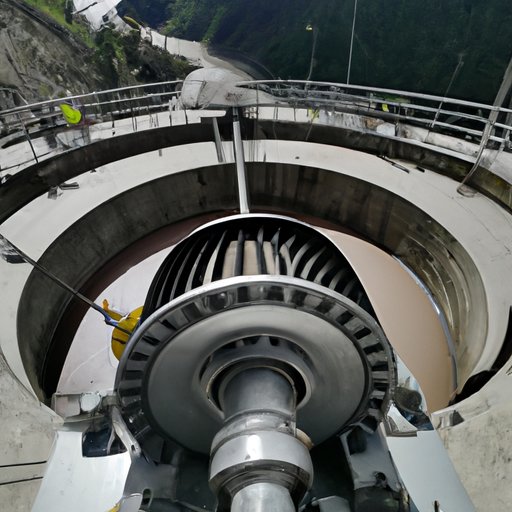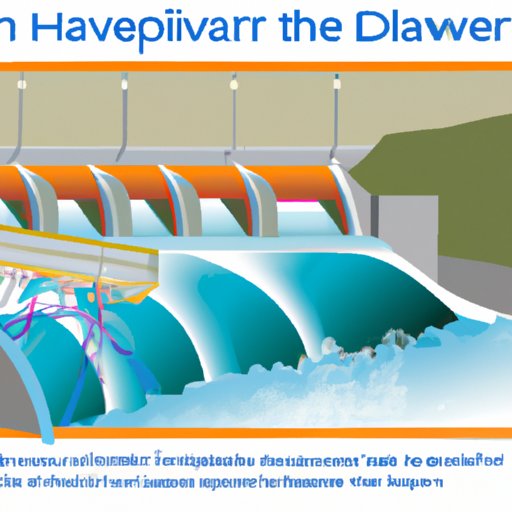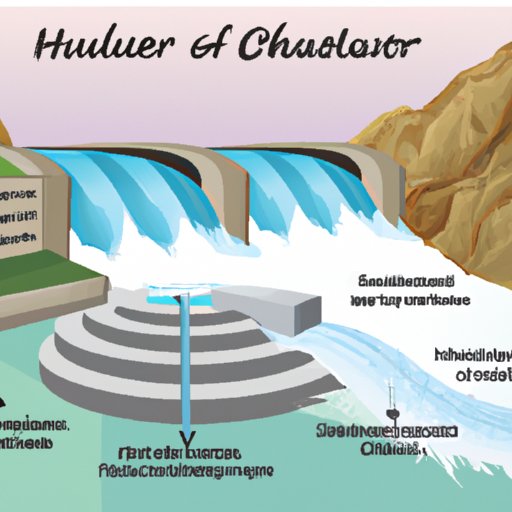Introduction
Hydropower, or hydroelectric power, is a form of energy that harnesses the power of moving water to generate electricity. It has been used for centuries as a reliable source of energy, but with advances in technology, its use has become even more widespread. In this article, we’ll explore how hydropower works and why it’s an important part of the renewable energy sector.
Exploring the Basics of Hydropower: How Does it Work?
Before delving into the details of how hydropower works, let’s take a look at what it is. Hydropower is a type of renewable energy that utilizes the natural flow of water to generate electricity. It relies on the movement of water—from river currents, tides, or man-made reservoirs—to turn turbines and generators that produce electricity.

Exploring the Mechanics Behind Hydropower Generation
The mechanics behind hydropower generation are relatively simple. Water is collected in a reservoir or river, then directed through a turbine. This turbine is connected to a generator, which produces electricity. The speed of the turbine is determined by the volume and pressure of the water flowing through it. Different types of hydropower plants use different methods to control the flow of water and the speed of the turbine.

The Science Behind Hydropower: How it Works
The science behind hydropower is complex, but the fundamental principle is fairly straightforward. When water flows through a turbine, it creates a rotational force that spins the blades of the turbine. This spinning motion is transferred to the generator, which converts the mechanical energy into electrical energy. The amount of electricity generated depends on the volume of water and the rate at which it is flowing.
According to the U.S. Department of Energy, “the amount of power generated by a hydroelectric plant depends on the flow and height (or head) of the water, the design of the turbine, and the efficiency of the generator.”1 There are several factors that can affect the output of a hydropower plant, including the availability of water, the size of the turbine, and the age and condition of the equipment.
Harnessing the Power of Water: A Look at Hydropower
Hydropower is one of the most efficient forms of renewable energy, offering numerous environmental and economic benefits. It is a clean, reliable, and cost-effective way to generate electricity, and it does not emit any harmful pollutants. Additionally, it is a renewable resource that can be used over and over again without the need for additional resources.
However, there are some drawbacks to using hydropower. One of the main disadvantages is the potential for environmental damage caused by the construction of dams and other infrastructure. Additionally, changes in water levels can cause flooding and erosion, as well as disrupt fish habitats and other wildlife.
An Overview of Hydropower and its Role in Renewable Energy
Hydropower plays an important role in the global renewable energy sector. According to the International Hydropower Association, “hydropower is the world’s largest source of renewable electricity, accounting for 16 percent of global electricity production in 2018.”2 Hydropower is a key component of many countries’ plans to reduce their dependence on non-renewable energy sources and combat climate change.
In addition to its potential for reducing emissions, hydropower also has the potential to provide reliable, affordable electricity to communities around the world. By utilizing existing water resources, hydropower can be deployed quickly and efficiently, providing access to electricity in places where it is otherwise difficult or expensive to obtain.

Understanding the Benefits of Hydropower: How it Works
Hydropower offers numerous economic and social benefits. From an economic standpoint, hydropower is a reliable and cost-effective source of electricity. It does not require the purchase of fuel, making it a more affordable option than traditional forms of energy production. Additionally, hydropower projects often create jobs and spur economic development in the areas they are located in.
From a social perspective, hydropower can provide electricity to remote communities and improve living standards. Additionally, because it is a renewable source of energy, it reduces our reliance on fossil fuels and helps protect the environment.
Exploring the Technology of Hydropower: How Does it Work?
Hydropower technology has advanced significantly in recent years, allowing for more efficient and cost-effective production of electricity. Many hydropower plants now utilize advanced technologies such as digital sensors, automated control systems, and computer monitoring systems to better manage water flow and turbine operation. Additionally, new technologies such as wave and tidal power are being developed to harness the energy of ocean waves and tides.
These advances have made hydropower an even more attractive option for energy producers and consumers. As technology continues to evolve, hydropower plants will become even more efficient and reliable sources of renewable energy.
Conclusion
Hydropower is a viable and cost-effective form of renewable energy that can provide reliable electricity and reduce our reliance on fossil fuels. Understanding how hydropower works is essential for anyone interested in exploring this type of energy production and its potential for a cleaner future. From the basics of its generation process to the economic and social benefits it offers, this article has provided an in-depth exploration of hydropower and its potential for powering a sustainable future.
(Note: Is this article not meeting your expectations? Do you have knowledge or insights to share? Unlock new opportunities and expand your reach by joining our authors team. Click Registration to join us and share your expertise with our readers.)
